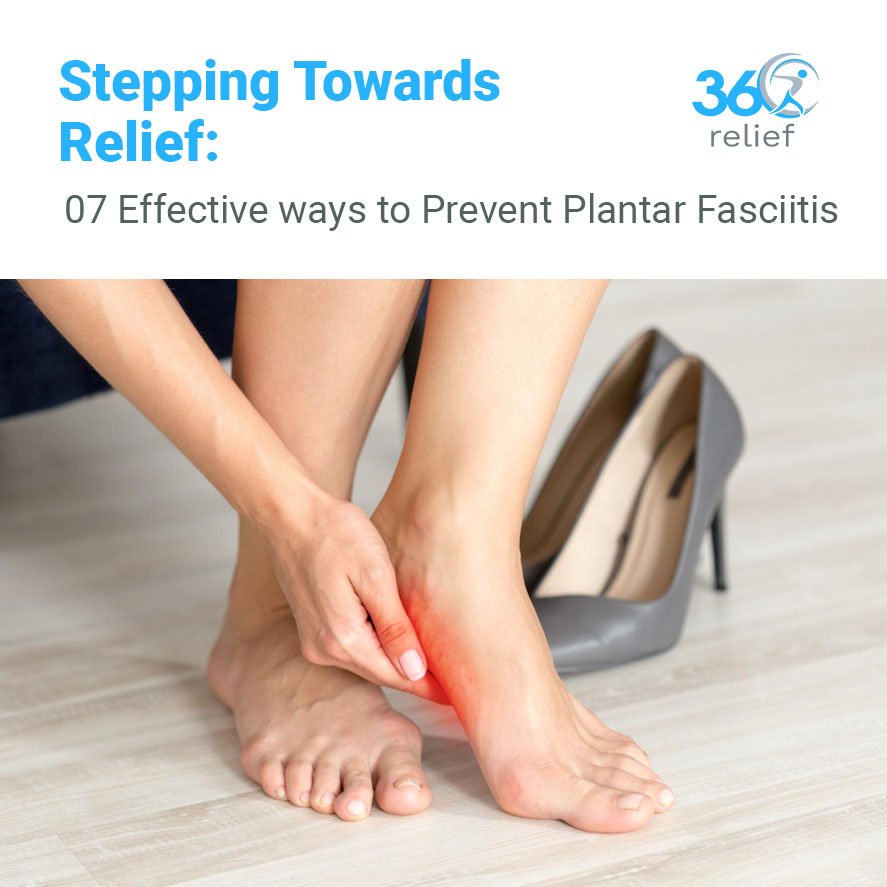
Make This Christmas Pain-Free: 10% Off on Supportive Wear!
Holidays are coming, which means that let’s welcome them with joy, laughter, and, of course, some comfort! At 360 Relief,

Plantar fasciitis is a common foot condition causing pain and other discomforts in the arch and heel of the foot. Plantar fasciitis results from the pain and inflammation of the plantar fascia. The Plantar fascia is a thick band of tissues running along the foot bottom. This thick band of tissues help connect the heel bone to the toe and supports the foot arch. As well as this, plantar fascia acts as a shock absorber during walking or running.
However, when subjected to repetitive actions or trauma and excessive stress, the plantar fascia becomes inflamed or irritated, resulting in plantar fasciitis. There are different factors contributing to the development of plantar fasciitis. The common symptoms may include pain and inflammation. However, people may also face other symptoms, depending upon the severity of the injury.
Plantar fasciitis, fortunately, is a treatable condition and there are a number of treatments or measures used to provide relief and promote healing. In this article, we are going to discuss in detail the common causes and symptoms of plantar fasciitis. We will also discuss the techniques for diagnosing and treating plantar fasciitis. However, we will complete our discussion with the 07 effective ways to prevent plantar fasciitis. So, let’s begin our discussion here;
Table of Contents
ToggleA combination of factors can cause plantar fasciitis, and understanding these causes is essential to diagnose and manage plantar fasciitis. Here we have discussed the most common causes of plantar fasciitis:
Pain is the basic symptom of plantar fasciitis. However, based on the intensity of the injury, you may also feel some other discomforts. Below given are other common symptoms resulting from plantar fasciitis:
Healthcare professionals follow different techniques to diagnose plantar fasciitis. Below are the common techniques used to diagnose plantar fasciitis:
The following are the commonly followed treatment plans for plantar fasciitis:

Check out the most effective ways to prevent the chances of plantar fasciitis:
Wearing proper footwear helps avoid putting extra stress on the foot arch or heel. Thus, it helps avoid the chances of plantar fasciitis. They also provide proper cushioning and support, helping you perform well.
The use of orthopaedic inserts provides additional arch support and cushioning. Thus, they help reduce stress on the plantar fascia.
Ensure that your body is fully warmed up before engaging in any physical activity or sports. A proper warm-up will help you avoid the chances of overuse injuries.
Always listen to your body and increase your activity gradually. Remember that overusing your ankles or foot may put extra stress on the plantar fascia, leading to plantar fasciitis.
Being overweight may put excessive stress or pressure on the feet or your feet may have to bear the load beyond their limits. So, try to maintain a healthy body weight to prevent the chances of plantar fasciitis.
Wearing foot support braces provides your feet with proper cushioning, support, and compression. Thus, they help improve circulation in the feet, avoiding the chances of plantar fasciitis and other overuse injuries.

Prolonged standing or walking may put excessive pressure on the plantar fascia, causing plantar fasciitis. Healthcare professionals advise avoiding prolonged standing or walking to keep your feet healthy.

Holidays are coming, which means that let’s welcome them with joy, laughter, and, of course, some comfort! At 360 Relief,

Happy Cyber Monday to everyone; it is a perfect occasion for 360 Relief to offer a special discount of 10%

This Black Friday, take advantage of exclusive 10% savings on some of 360 Relief’s best-selling compression socks and support braces!

Everyday life includes walking up stairs, but knee discomfort can make this basic activity difficult. Walking up or down stairs

Cooking is a beloved activity for many, but for those struggling with knee pain, standing in the kitchen can quickly

We’ve all been there. On a ride in a car, for instance, to the country home for a weekend break

Gardening is enjoyable for many people and those who like tending to their lawns and plants usually find it therapeutic

Do you have a painful knee problem that takes you to physiotherapy…for an injury that hampers your daily living…your workout

Training can be very much associated with some pains and injuries that may be experienced by the trainers. As there

Office workers often spend hours seated at their desks, focusing on tasks while unknowingly putting their health at risk. The

Winter often brings more than just a change in weather; for many, it also means dealing with unexpected swelling in

Compression socks have become a critical tool for athletes across all sports. Whether you’re a marathon runner, cyclist, or weightlifter,

October marks the beginning of National Cholesterol Month in the UK, a time dedicated to raising awareness about cholesterol and

Overall, there is nothing to match the experience of watching musicians perform live in an outdoor concert in Glastonbury. However,

Today charity runs have gained popularity as a way of raising cash for a cause in the United Kingdom. From
Please enter your email to subscribe to our newsletter for exclusive offers and updates
Copyright © 2025 | 360 Relief Ltd | Sitemap

